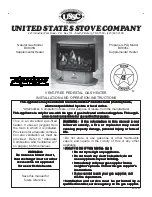
26 www.hotwater.com
dirt or foreign material in the gas supply line, a sediment
trap (sometimes called a dirt leg) must be incorporated in
the piping. The sediment trap must be readily accessible.
Install in accordance with the “Gas Piping” section. Refer to
the current edition of the
National Fuel Gas Code (ANSI
Z223.1/NFPA 5 4)
.
HOT-WATER
OUTLET
COLD-
WATER
INLET
UNION
TEMPERATURE-
PRESSURE
RELIEF VALVE
DISCHARGE PIPE
(DO NOT CAP
OR PLUG)
6” (150mm) MAX.
AIR GAP BELOW
DISCHARGE PIPE
METAL
DRAIN
PAN
FLOOR
DRAIN
DRAIN
VALVE
SHUT-OFF VALVE
SOME
COMPONENTS
NOT SHOWN
FOR CLARITY.
SIDE TAP
(OUTLET)
SIDE TAP
(INLET)
Figure 28
FILLING THE WATER HEATER
•
Avoid water heater damage.
•
Fill tank with water before operating.
Property Damage Hazard
CAUTION
Do not insert the power cord into the electrical
receptacle until the heater has been fully installed.
Never use this water heater unless it is completely full
of water. To prevent damage to the tank, the tank must
be
fi
lled with water. Water must
fl
ow from the hot-water
faucet before turning “ON” gas to the water heater.
•
•
To
fi
ll the water heater with water:
1. Close the water heater drain valve by turning handle
to the right (clockwise). The drain valve is on the lower
front of water heater (see Figure 28).
2. If the heater is equipped with plumbing side taps and
they are not connected to piping, ensure that the side
taps have been closed with pipe plugs.
3. Open all hot-water faucets served by the water heater to
allow air to escape from the tank and the water piping.
Ensure any shut-off valves between the heater and the
faucets are the open position.
4. Open the cold-water supply valve to the water heater.
Notes:
• The cold-water supply valve must be left open when
the water heater is in use.
• Avoid water leakage when filling the tank. Do
not allow the insulation of the water heater to get
wet as water can reduce the effectivness of the
insulation.
5. To ensure complete
fi
lling of the tank, allow air to exit
by opening nearest hot-water faucet. Allow water to run
until a constant
fl
ow is obtained. This will let air out of
the water heater and the piping.
6. Check all water piping and connections for leaks. Repair
as needed.
VENTING
Breathing carbon monoxide can cause brain damage or death.
Always read and understand instruction manual.
•
Install vent system In accordance with codes.
•
Do not operate water heater if flood damaged.
•
Install water heater in accordance with the
instruction manual.
•
Do not operate if soot buildup is present.
•
Do not obstruct water heater air intake(s) with
insulating blanket.
•
Do not place chemical vapor emitting products near
water heater.
•
Gas and carbon monoxide detectors are available.
•
Never operate the heater unless it is vented to the
outdoors and has adequate air supply to avoid risks
of improper operation, fire, explosion or asphyxia-
tion.
•
Analyze the entire vent system to make sure that
condensate will not become trapped in a section of
vent pipe and therefore reduce the open cross
sectional area of the vent.
Breathing Hazard - Carbon Monoxide Gas
WARNING
Important:
DO NOT common vent this water heater with
any power vented appliance. DO NOT vent into a common
chimney.
















































